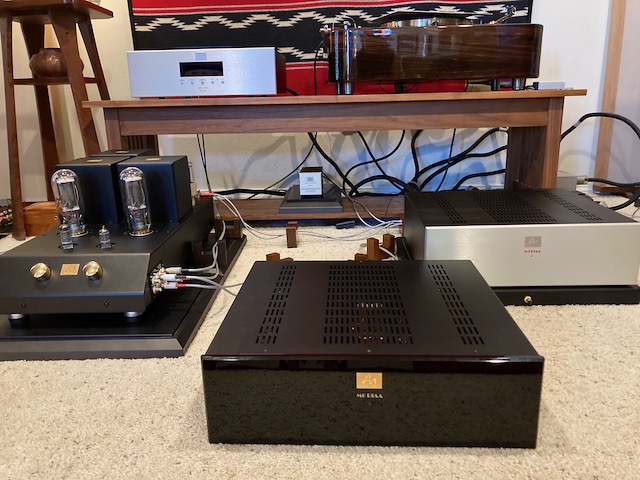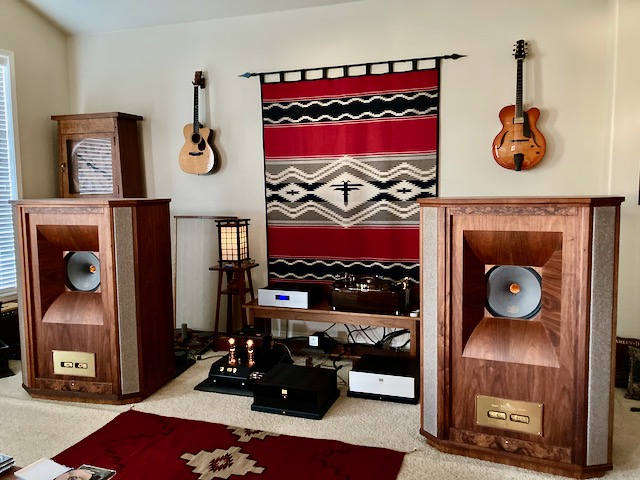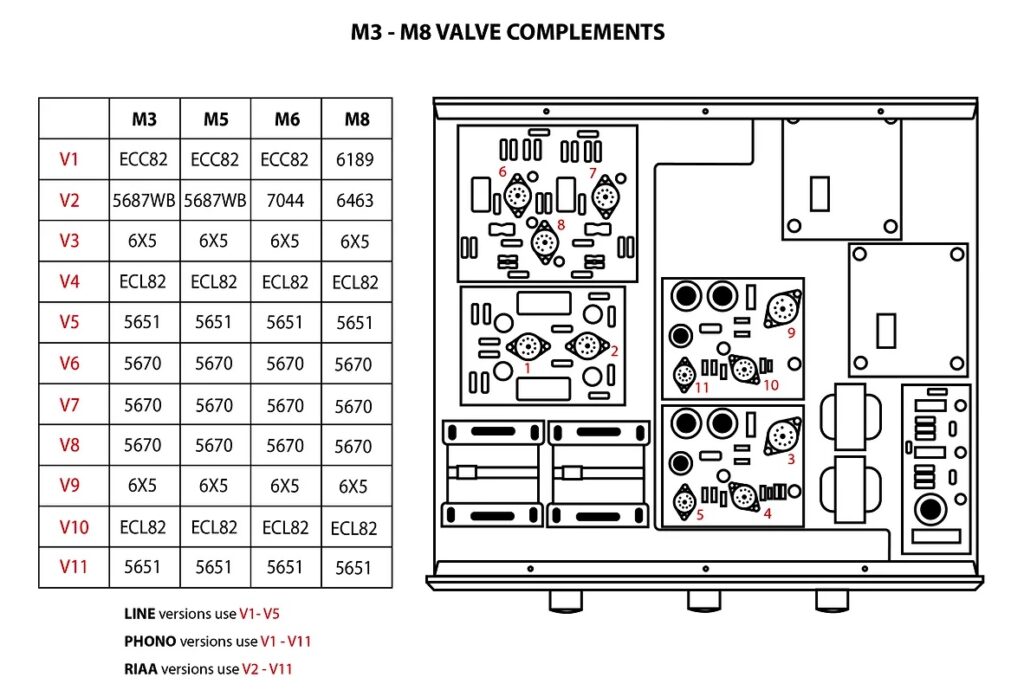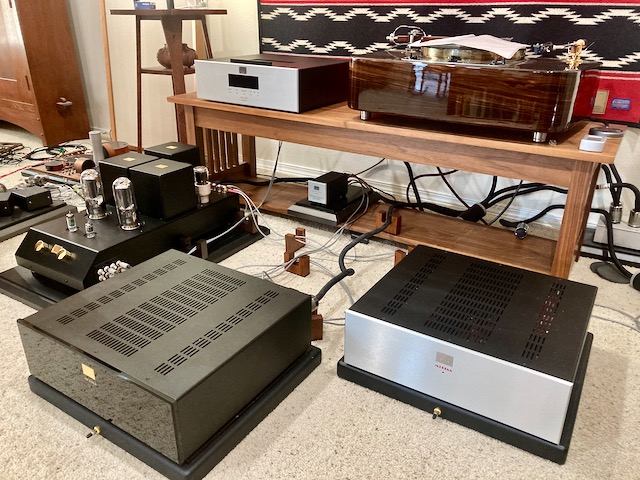I hope you had a chance to read my feature article for Positive Feedback about the M3 RIAA phono preamp in combination with the Tomei 211 SET integrated amplifier (HERE).
I was totally stunned by the level of performance the M3 RIAA phono stage and Tomei 211 SET integrated amplifier combination offered, to the extent that I was trying to figure out some new audio reviewing vocabulary to describe their performance, as they demonstrated a number of lofty performance attributes outside of what the current reviewing vocabulary can fully address.
In the Audio Note (UK) performance hierarchy, the Tomei 211 SET integrated amplifier is at Level Four, and the M3 RIAA is at Level Three.
Peter Qvortrup suggested I give the Level Four M6 RIAA phono preamplifier a listen (above middle), as it would be a good demonstration of the performance enhancement between the Level Three M3 RIAA (above right) and the Level Four M6 RIAA.
Many thanks to Peter for sending along the M6 RIAA phono preamp to listen to and tell you about.
Also, enticingly, that makes for a demonstration of a big slice of Audio Note (UK) Level Four performance, with the Tomei 211 SET integrated amplifier, M6 RIAA phono preamp, and the silver AN-S4 step-up transformer, all being at the lofty Level Four Audio Note (UK) performance level.
As you might imagine, I'm positively giddy about hearing the M6 RIAA in this Level Four audio system context, and I'm going to have to give some serious thought to expanding my audio reviewing vocabulary to capture this Level of performance.
That's not as easy as it sounds, because when you start hearing audio equipment that dramatically breaks new ground in certain aspects of performance, it is not that easy to fully articulate exactly what it is doing.
Ok, I'm getting ahead of myself.
Let me tell you a little more about the difference between the Level Three M3 RIAA and the Level Four M6 RIAA.
First of all, the M3 RIAA phono stage is the first step of M3-M8 pre-amplifier family, all of which share the same circuit topology across the range (M3, M5, M6, and M8), with parts quality upgraded level by level within the range.
The Audio Note (UK) M3 through M8 RIAA phono preamplifier product line utilizes no negative feedback (NFB), and features the use of passive CR RIAA equalization.
Using no NFB is the purest high-performance way to build a phono preamplifier, and avoids the use of performance reducing NFB, as other valve phono stages do.
You can think of the no NFB approach to phono preamplifier design as the purity equivalent of a single-ended-triode amplifier compared to a push-pull amplifier, as more important signal information comes through than would be possible when using NFB in a circuit.
The overall specifications for the M6 RIAA phono preamplifier are an input sensitivity of 47 kΩ, an input sensitivity of 126 mV for 1 V output, an output impedance of <10 Ohms, a weight of approximately 37.5 pounds, and dimensions of 5.5 inches high, by 17.3 inches wide, and 16 inches deep.
Ten vacuum tubes are used in the M6 RIAA's circuits: a single 7044 for V2 (the M3 uses a 5687WB), 2 x 6X5 in V3 and V9, 2 x ECL82 in V4 and V10, 2 x 5651WA in V5 and V11, and 3 x 5670W/2C51W in V6-8 (above).
Both the M3 & M6 RIAA feature pure Class A operation, zero negative feedback, single-ended circuit topology, valve rectification, and where the M6 attains its Level Four designation over the M3's Level Three designation, is in the materials and component quality of the circuit topology.
Level Three & Four Differences
As noted above, the M6 RIAA features an ECC82 and 7044 in the line stage, whereas the M3 RIAA features an ECC82 and 5687WB in the line stage.
The M6 utilizes Audio Note (UK) silver wiring (M3 has copper wiring) and tantalum resistors. Audio Note (UK) custom electrolytic capacitors and Audio Note (UK) copper foil signal capacitors are used throughout the M6's circuit. In the M6, in-house designed and manufactured, custom Audio Note (UK) output transformers, which feature a UHiB c-core, copper primary and silver secondary windings are featured (whereas the M3 has Audio Note (UK) output transformers with I-E M4 cores and copper windings).
In a future article, I'll pop the top off the M3 and M6 so we can do a visual "walkthrough" of the differences in the valves/components of the two phono preamplifiers, so stay tuned for that.
To gather listening impressions, I've placed the M3 RIAA and M6 RIAA on identical Acoustic Revive air isolation platforms, and will be using the same interconnects and power cord for comparisons.
At the moment I'm in the bedding in process for M6 RIAA. The bedding-in time for the M6 RIAA is 100 hours, so I am exercising my patience while the M6 RIAA approaches its full performance level.
For additional information, you can read through the owner's manuals for the M3 RIAA (HERE) and the M6 RIAA (HERE).
A big "Thank you!" to Peter Qvortrup for sending the M6 RIAA so I could listen to it and tell you about it here at Jeff's Place, and in its future feature review at Positive Feedback.
The Level Three Audio Note (UK) M3 RIAA is priced at $11,314.00 USD, and the Level Four Audio Note (UK) M6 RIAA is priced at $23,383.00 USD.
As always, thanks for stopping by, and may the tone be with you!

































